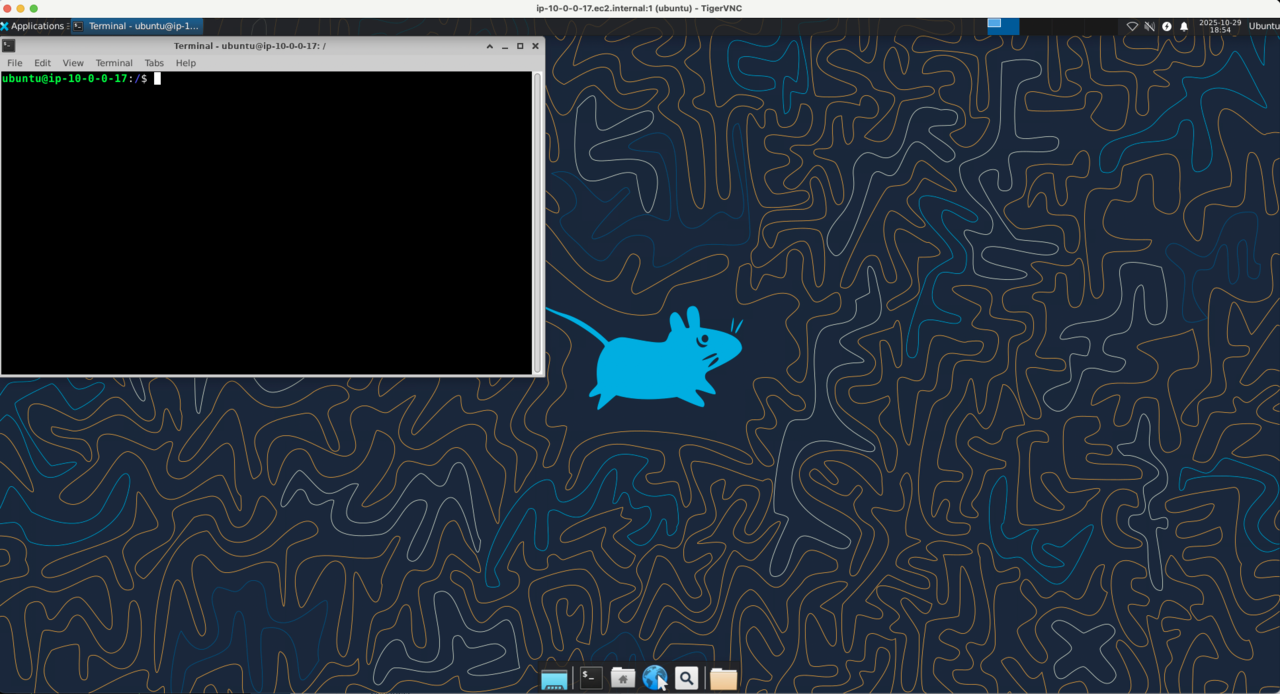VNC on Arm Linux
About this Install Guide
| Reading time: | 15 min |
| Last updated: | 24 Nov 2025 |
| Test status: |
| Reading time: |
| 15 min |
| Last updated: |
| 24 Nov 2025 |
| Test status: |
This guide is intended to get you up and running with this tool quickly with the most common settings. For a thorough review of all options, refer to the official documentation.
Virtual Network Computing (VNC) is one of the common tools used to connect to a remote Linux desktop. During development, it can be useful to quickly create a remote desktop on an Arm server.
This guide provides information about how to set up VNC on a remote Arm Linux machine.
This installation only works on newer versions of Ubuntu and Debian. It was successfully tested on Ubuntu 22.04 and Ubuntu 24.04.
What is VNC?
VNC is a client-server application. A VNC server runs on a remote machine. A VNC client runs on the local machine and connects to the remote server.
How do I install the VNC server and xfce4 desktop?
To use VNC, you need to install a VNC server. There are multiple VNC servers you can use. This guide uses TigerVNC .
You also need desktop software. There are many options for this, but using xfce4 provides a minimal install with good performance.
Install the desktop software:
sudo apt-get install xfce4 xfce4-goodies xorg dbus-x11 x11-xserver-utils xfce4-terminal -y
Install the VNC server:
sudo apt-get install tigervnc-standalone-server tigervnc-common -y
How do I set a VNC password?
Run the vncpasswd command to set a password for VNC. This is not the password for your user account, but for the VNC client to connect to the VNC server.
vncpasswd
Remember this password for later when you connect the client.
How do I configure the desktop startup for VNC?
Create a file at $HOME/.vnc/xstartup with the following contents:
#!/bin/sh
# select your favorite windows manager here
/bin/bash -l <<EOF
exec /etc/X11/Xsession startxfce4
EOF
Make sure the xstartup file has executable permissions:
chmod +x $HOME/.vnc/xstartup
How do I set up a systemd service to manage VNC?
To create a systemd service to start the VNC server, create the file /etc/systemd/system/vncserver@.service.
Use sudo or root privileges because this file is in a system directory.
If your username is not ubuntu change the User value to match your username after you create the new file.
[Unit]
Description=Remote desktop service (VNC)
After=syslog.target network.target
[Service]
Type=simple
User=ubuntu
PAMName=login
PIDFile=/home/%u/.vnc/%H%i.pid
ExecStartPre=/bin/sh -c '/usr/bin/vncserver -kill :%i > /dev/null 2>&1 || : '
ExecStart=/usr/bin/vncserver :%i -localhost no -geometry 1440x900 -alwaysshared -fg
ExecStop=/usr/bin/vncserver -kill :%i
[Install]
WantedBy=multi-user.target
The following commands are for any Linux distribution that uses systemd.
To start the VNC service:
sudo systemctl start vncserver@1.service
To stop the VNC service:
sudo systemctl stop vncserver@1.service
To restart the VNC service:
sudo systemctl restart vncserver@1.service
How do I use port forwarding via SSH to connect to VNC?
The default port for the first instance of VNC is 5901. SSH port forwarding is the recommended solution for accessing the Linux desktop on a cloud machine. This way, no additional ports need to be opened in the security group.
SSH to your remote Linux machine. See SSH for additional details.
Substitute your private key file and the public IP address of the remote machine in the following command:
ssh -i <private_key> -L 5901:localhost:5901 ubuntu@<public_ip_address>
Once connected via SSH, use a VNC client to connect. Download and install a TigerVNC client for your computer.
Open the VNC client and enter the following for the VNC server:
localhost:5901
You will be prompted for the password you created earlier with vncpasswd.
A remote Linux desktop should appear on your local computer. When you are finished, close the VNC client first and then exit the SSH connection.

Give Feedback
How would you rate this tool quick-install guide?
What is the primary reason for your feedback ?
Thank you! We're grateful for your feedback.
- Have more feedback? Log an issue on GitHub.
- Want to collaborate? Join our Discord server.